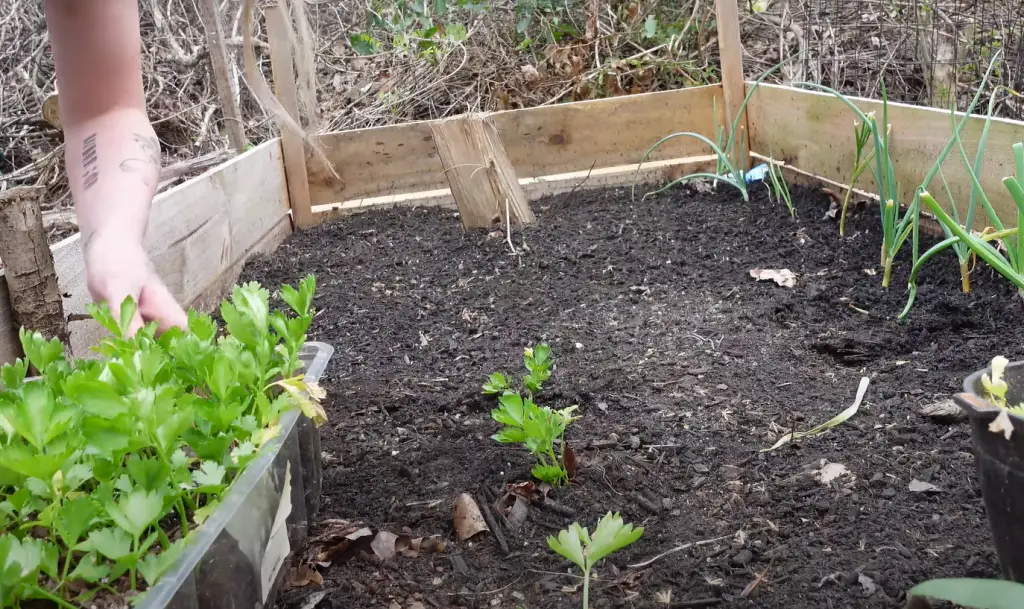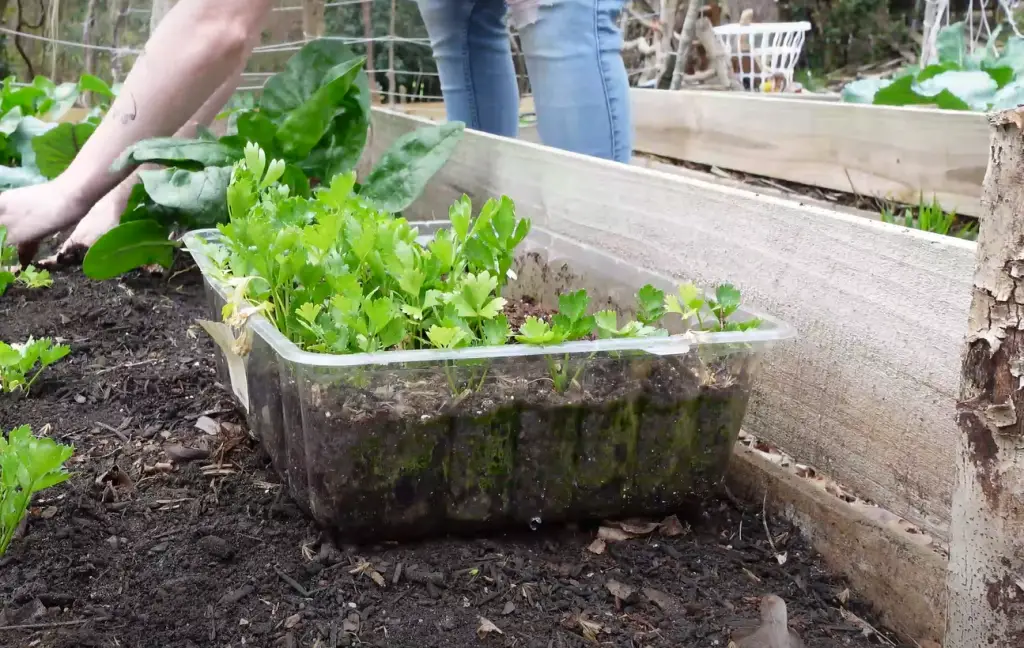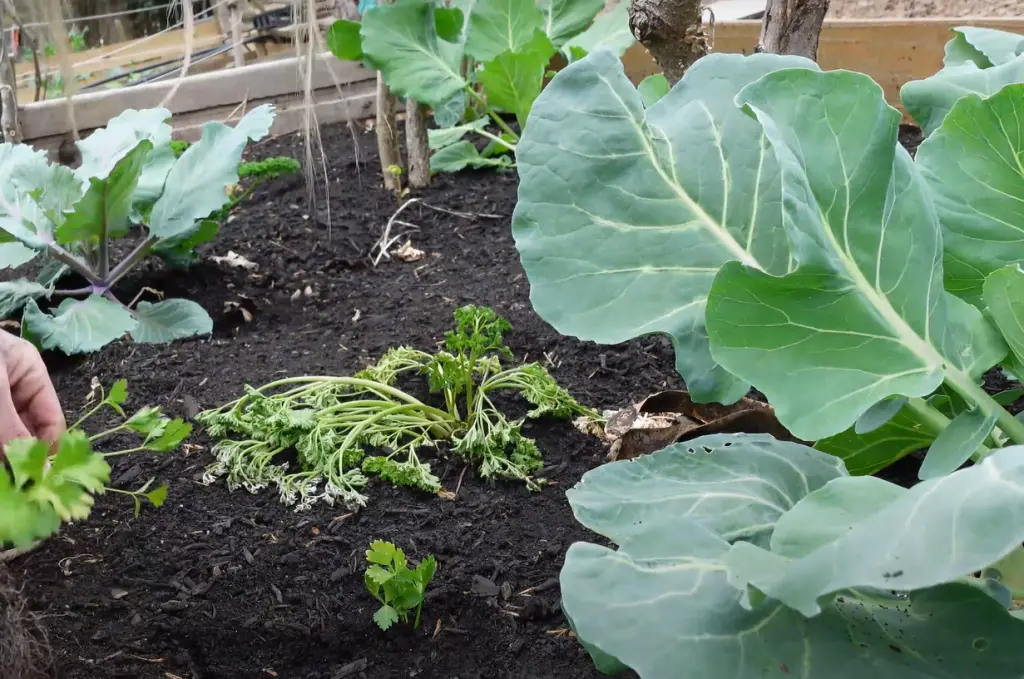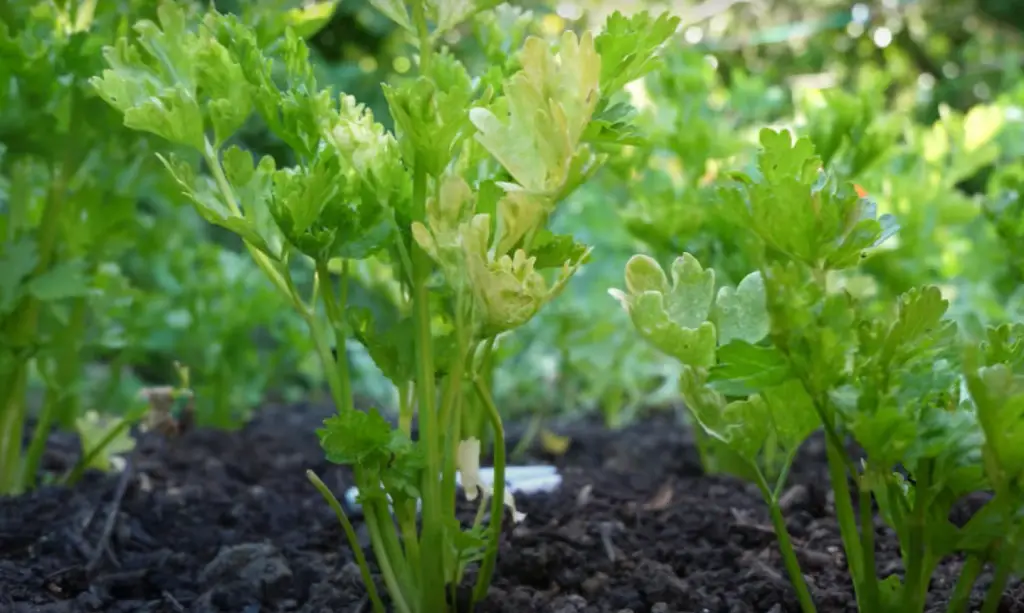Celery is a delicious and versatile vegetable that can be used to make many dishes. However, growing celery in your garden requires more than just seed and soil. Selecting the right companion plants for your celery crop is an important step to ensure healthy growth and a successful harvest.
In this article, we’ll take a look at some of the best companion plants for celery, how they can help your crop, and what to avoid. With this information in hand, you’ll be able to create an ideal environment for growing delicious celery.
What is companion planting?
Companion planting is a simple but effective method of gardening in which two or more compatible plants are grown together to achieve the best results.
By choosing helpful companion plants, you can encourage your celery crop to grow healthier and larger with fewer pests and diseases. [1]
What are the BEST celery companion plants?
When it comes to choosing the best companion plants for celery, there are a few that stand out. Tomatoes, beans, basil and carrots all make excellent companions to celery in the garden.

These vegetables can encourage your celery crop to thrive while adding flavour and nutrition to your home-grown dishes.
What are some other good companion plants for celery?
Aside from tomatoes, beans, basil and carrots, there are a few other plants that make great companions for celery.
Onions also do well in combination with celery as they discourage pests and diseases while providing additional nutrients to the soil.
What are bad companion plants for celery?
While certain plants can be beneficial to celery, there are a few that should be avoided. Peppers, potatoes and turnips will all compete with the celery for resources like water and nutrients.
Additionally, these vegetables may attract pests or diseases that could otherwise have been kept away with helpful companion plants.
Why should I try companion planting?
Companion planting is a great way to encourage healthy growth and reduce pests or diseases in your celery crop. With the right companion plants by its side, your celery will have access to additional resources such as nutrients, water and even beneficial insects.
Additionally, companion planting can help you make the most of your garden space by utilising the different needs of various vegetables.
What Are The Benefits?
The benefits of companion planting include healthier plants with higher yields, fewer pests and diseases, improved soil structure and fertility, and enhanced flavour in your home-grown dishes.

Additionally, this method of gardening can help conserve resources like water and nutrients as well as reduce the need for chemical fertilisers or pesticides. [2]
FAQ
What should not be planted next to celery?
Peppers, potatoes and turnips should not be planted next to celery as these vegetables will compete with the celery for resources like water and nutrients.
Additionally, these plants may attract pests or diseases that could otherwise have been kept away with helpful companion plants.
What is a good insect-repellent plant for celery?
Onions are a great insect repellent for celery as they discourage pests and diseases while providing additional nutrients to the soil. Planting onions near your celery crop can help keep away some of the most common pests that may otherwise damage your celery plants.
Are there other benefits to companion planting?
Yes, there are several other benefits to companion planting. This method of gardening can help conserve resources like water and nutrients as well as reduce the need for chemical fertilisers or pesticides.
Additionally, companion planting can help make the most of your garden space by utilising the different needs of various vegetables.
Where does celery like to be planted?
Celery prefers to be planted in a location that receives full sun and is well-drained.
How much space does celery need?
Celery requires plenty of space for it to grow and thrive. Plant your celery seedlings at least 8-10 inches apart to allow them room to expand.
Additionally, it’s important to provide enough support for the plants as they grow taller and heavier as this will help prevent breakage or disease.
Is celery a light feeder?
Yes, celery is a light feeder and doesn’t require much fertiliser. However, it’s still important to provide your plants with the necessary nutrients for healthy growth. Consider adding organic compost or manure to the soil prior to planting and supplementing with a balanced fertiliser throughout the season.
Does celery need a lot of sun?
Yes, celery requires full sun for the best results. Make sure to select a location in your garden that receives at least 6-8 hours of direct sunlight each day. If you’re planting indoors, consider investing in a grow light to ensure your plants get enough light throughout the season.
Does celery take a lot of water to grow?
Celery requires plenty of water to grow and thrive. Aim to provide your plants with about an inch of water a week.
However, it’s important to make sure the soil is not soggy or overly wet as this can cause root rot or other diseases. Be sure to check the soil before watering and adjust your schedule accordingly.
What do I need to know about harvesting celery?
Celery is typically ready to harvest within 3-6 months after planting. Before harvesting, be sure to check the stalks for signs of disease or pests.

Additionally, make sure the stalks are firm and crisp before cutting them from the plant. When cut properly, you can enjoy your freshly harvested celery for days to come!
What is the best way to store celery?
The best way to store celery is by wrapping it in a damp cloth and keeping it in an airtight container. This method should help keep your celery fresh for up to a week.
Additionally, you can also freeze your celery for later use. Simply cut the stalks into pieces, blanch them and then freeze them in airtight containers.
What dishes can I make with celery?
Celery is a versatile vegetable that can be used in many different recipes. Consider adding it to stir fry, soups and stews for a boost of flavour.
Additionally, you can also use celery in salads, sandwiches or as a side dish. Celery is also great when juiced, blended into smoothies or cooked down into jam.
What are some tips for growing celery?
When it comes to growing celery, there are a few key things to keep in mind. First, make sure to plant your celery seedlings in a location that receives full sun and is well-drained.
Additionally, make sure the soil is loose and rich in organic matter as this will promote strong root growth and healthy plants. Lastly, provide your celery with plenty of water and supplemental nutrients throughout the season.
How can I encourage more pollinators in my garden?
Encouraging pollinators to visit your garden is a great way to ensure healthy celery growth. Planting a variety of flowers and herbs near your celery crop will help attract beneficial insects such as bees and butterflies which, in turn, will help pollinate the plants.
Additionally, you can also provide resources like water, shelter and nesting sites to further entice pollinators.
How can I keep pests and diseases away from my celery crop?
The best way to protect your celery crop from pests and disease is by using companion planting. Planting helpful herbs like thyme, rosemary, oregano or basil near your celery will deter harmful insects while providing additional nutrients to the soil.
Additionally, consider adding insect-repelling plants like onions to your garden as this may help discourage pests from damaging your celery.
How can I tell if my celery is overwatered?
If your celery is overwatered, the stems may start to yellow and become soft or limp. Additionally, you may also notice a foul smell coming from the soil as this could be an indication of root rot.
If you suspect your celery has been overwatered, it’s important to adjust your watering schedule and ensure the soil is well-draining.
Additionally, consider adding some organic matter to the soil as this can help improve drainage and provide additional nutrients.
Is celery difficult to grow?
No, celery is not particularly difficult to grow as long as you provide it with the right conditions and care. As long as you select a location that receives full sun, keep the soil moist and provide your plants with plenty of nutrients, you should be able to successfully grow celery in your garden.

Additionally, make sure to check for pests or diseases throughout the season and take action when necessary.
Which companion plants work best with celery?
Some of the best companion plants for celery include tomatoes, carrots, onions, garlic, rosemary and oregano. These plants can help improve nutrient cycling in the soil while also helping to deter pests and diseases.
Additionally, they can provide your celery crop with extra nutrients that may be lacking. Consider planting these helpful companions near your celery to ensure a healthy and bountiful harvest.
What are the benefits of companion planting with celery?
Companion planting has many benefits for celery crops. Not only can it help deter pests and disease, but it can also promote nutrient cycling in the soil while providing additional nutrients for your plants.
Additionally, companion planting can help attract beneficial insects to your garden which will help with pollination and healthy growth of the celery.
How can I use companion plants to attract beneficial insects?
Attracting beneficial insects to your garden can help ensure healthy growth for your celery crop. Consider planting flowers and herbs that will attract beneficial bugs such as bees, butterflies and ladybugs. Additionally, providing resources like water, shelter and nesting sites may also encourage these helpful insects to stick around and provide pollination services to your plants.
Does it matter when I plant companion plants?
Yes, the timing of when you plant your companion plants can be important. Consider planting your celery crop and companions at the same time or shortly after one another so they can benefit from the same growing conditions.
Additionally, make sure to pay attention to each plant’s light and water requirements as this will help ensure successful growth for all of your plants.
What other ways can I use companion plants to enhance my celery crop?
Companion plants can not only help attract beneficial insects, but they can also improve nutrient cycling in the soil and provide additional nutrients to your celery crop.
Additionally, you can also use companion plants to create a living mulch which will help keep the soil moist and provide additional ground cover for your celery. Consider adding a variety of plants to your garden to ensure a healthy celery crop.
Can I use companion plants indoors?
Yes, you can absolutely use companion plants indoors. However, it’s important to select appropriate varieties depending on the amount of light and space available.
Additionally, make sure to provide your indoor plants with enough water and nutrients as this will help ensure healthy growth for all of your plants.
Does companion planting have any other benefits?
In addition to promoting healthy growth for your celery crop, companion planting can also create a beautiful and diverse garden. Consider adding flowers, herbs and vegetables to your garden bed which will bring colour and texture as well as attracting helpful beneficial insects.
Additionally, companion plants can provide visual interest in the winter months when traditional crops are no longer producing.
Do I need to adjust my watering and fertilising schedule when companion planting?
It’s important to pay attention to the water and nutrient needs of each plant in your garden. Depending on the type of companion plants you have selected, you may need to adjust your watering and fertilising schedule accordingly. Additionally, make sure to keep an eye on the soil moisture levels as wilting plants may be an indication of overwatering or underwatering.
Does companion planting require any special care?
Although companion planting is relatively easy to do, it’s important to provide sufficient space between the plants so they can all receive the light and nutrients they need.
Additionally, make sure to keep an eye on your plants throughout the season and remove any dead or diseased plants promptly in order to avoid spreading disease or pests.
Do I need to rotate my companion plants each season?
Yes, it’s important to practise crop rotation when companion planting in order to avoid soil-borne diseases. Consider planting different varieties of companions in different beds each season and rotating them accordingly so disease can’t build up in the soil.

Additionally, this will also help ensure that your plants receive all the nutrients they need and will help maintain soil health.
Can I use companion planting for container gardens?
Yes, companion planting is also applicable to container gardens. Make sure to select appropriate varieties which can thrive in a smaller space and pay attention to the soil moisture levels as containers tend to dry out more quickly than traditional garden beds.
Additionally, consider fertilising your plants throughout the season as this will help ensure they get all the nutrients they need.
Can I use companion planting for indoor hydroponic gardens?
Yes, you can use companion planting in an indoor hydroponic garden. However, it’s important to pay attention to the specific needs of each plant as hydroponics requires different nutrient levels and pH balance than traditional soil-based gardening.
Additionally, make sure to keep an eye on the temperature and humidity levels as this will help ensure healthy growth for all of your plants.
Do I need to adjust my fertilising schedule when companion planting?
Yes, it’s important to adjust your fertilising schedule depending on the specific needs of each plant in your garden bed.
Additionally, make sure to check the soil pH levels regularly as this will help ensure that your plants receive all the nutrients they need for healthy growth.
Does companion planting require any special tools?
No, you don’t need any special tools for companion planting. However, it can be helpful to have a soil tester so that you can accurately measure the pH levels of your soil and ensure that your plants are getting all the nutrients they need.
Additionally, you may also want to invest in a watering wand which will help you distribute water evenly and accurately to all of your plants.
Do I need to prune my companion plants?
Yes, pruning your companion plants can help ensure healthy growth and protect them from disease. Make sure to remove any dead or diseased branches promptly and give the plant a good trim when needed.
Additionally, consider cutting back perennial plants such as lavender in early spring before new growth begins in order to encourage bushier and more robust growth.
Does companion planting require any additional maintenance?
Companion planting does not require any additional maintenance beyond the regular care needed for each plant. Make sure to water and fertilise your plants accordingly and give them enough space so that they can all receive the light and nutrients they need.
Additionally, consider adding a layer of mulch around your plants in order to help keep weeds at bay and retain moisture in the soil.
Do companion plants need to be harvested at the same time as my celery crop?
No, you don’t need to harvest your companion plants at the same time as your celery crop. Make sure to note when each plant matures so that you can harvest them accordingly.
Additionally, consider staggering your planting schedule by planting different companion plants at different times in order to ensure that there is always something blooming and providing food for beneficial insects.
Useful Video: Growing Celery with Companion Plants | Hollow Acres Homestead
Conclusion
Companion planting is an easy and effective way to encourage healthy growth for your celery crop as well as creating a beautiful garden.
Make sure to choose the right companion plants, adjust your watering and fertilising schedule accordingly and practice crop rotation in order to ensure success.
Additionally, pay attention to the specific needs of each plant in your garden bed in order to ensure that all of your plants get the light and nutrients they need. With a bit of careful planning, companion planting is an easy and rewarding way to create a bountiful garden!
References:
- https://growfully.com/celery-companion-plants/
- https://borealbloomhomestead.com/celery-companion-plants/










Leave a Reply
View Comments